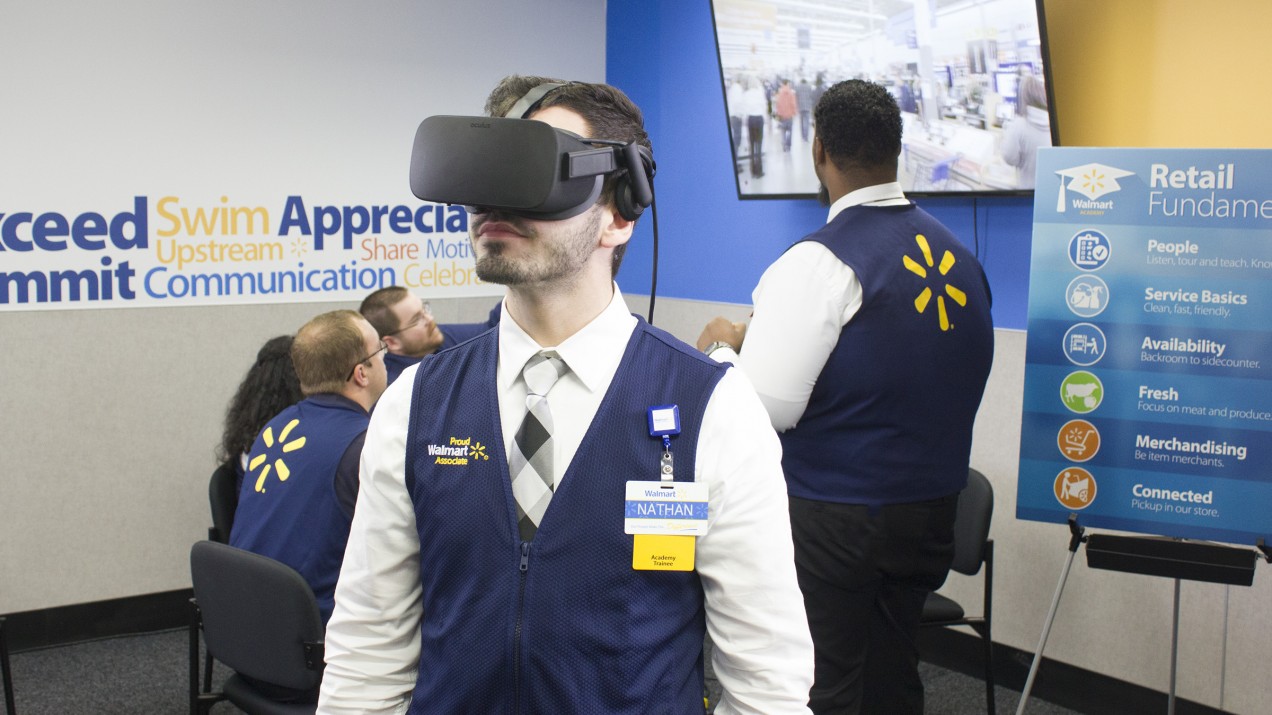

Connectivity
Finally, a Useful Application for VR: Training Employees
It’s not that glamorous, but everyone from Walmart to the NFL is using it.

If you’ve ever been inside a Walmart during the annual frenzy known as Black Friday, you know there’s no way to truly prepare yourself for the crushing crowds and panic-fueled shopping—you have to see it to believe it. But wearing a virtual-reality headset that lets you stand in the middle of this madness comes pretty close.
I would know; I’ve never worked a Black Friday shift as a retail employee, but I have covered it as a reporter. And when Strivr, a startup that uses VR to help companies with employee training, recently used a headset to show me a Black Friday rush captured for Walmart, which is a customer, I felt the same shiver run up my spine that I’ve felt in real life.
This experience and several others Strivr let me try in San Francisco and at the company’s Silicon Valley office—including one where I stood in the middle of a football play—show off a bit of what it is building for customers that range from the retail giant to NFL teams. Strivr works with companies to make personalized virtual experiences that can be created quickly, with 360° cameras and software, and then used to help all kinds of employees hone skills that can be applied in a store, on a playing field, or somewhere else entirely.
“Our product vision is about creating the flight simulator for blank: insert job here,” says Derek Belch, Strivr’s founder and CEO.
Virtual reality is not yet widely used by anyone: the best hardware is too clunky and expensive for most of us to want to use more than occasionally, and there isn’t a ton of stuff to do with it, either. Some companies are starting to experiment with it, but it is not yet clear how it might help the bottom line. For now, the technology is more popular with consumers, though that’s still a tiny market.
It makes sense that sports are a big part of Strivr’s customer base. As a graduate student and football coach at Stanford in 2014, Belch started Strivr to help train players, who can only be on the field for a certain amount of time. He figured that watching filmed plays on a VR headset could be a more immersive (and realistic) way to train than just watching videos, shot from the angles viewers typically see, on a flat screen.
So Belch began experimenting, filming football practices once a week with a 360° rig of GoPro cameras set up to show blitzes from the quarterback’s point of view. The results, he said, were really good. So good, in fact, that as he finished his master’s program at Stanford, he decided to turn his project into a company. Stanford’s head football coach, David Shaw, invested in it and is now listed as an advisor to the startup.
These days Strivr, which sits midway between Facebook’s headquarters and Belch’s alma mater on a busy corner in Menlo Park, has branched out far beyond football. In addition to Walmart and various NFL and other sports teams, it’s working with United Rentals, two car makers, and numerous other customers. Stanford still uses it, too, Belch says, filming about 80 plays per week.
Related Story
People in Virtual Reality Are About to Look a Lot More Realistic
8i is trying to bring real people into virtual reality for more immersive experiences, from films to yoga classes.
Companies subscribe to Strivr (it wouldn’t say how much its services cost), and the startup provides them with 360° cameras for filming, software that processes the footage, and an Oculus Rift headset to watch everything on. And since Rift keeps track of things like how your head moves in space, Strivr can use that data to give customers a sense of what employees are paying attention to in VR.
At Walmart, at least, Brock McKeel, senior director of digital operations, thinks it’s helpful. He says the company uses Strivr in about 187 employee training centers, for three types of training: preparing for situations like Black Friday or emergencies where you can’t set up a simulation in a store, learning customer service, and teaching operational stuff like how produce should be stacked and arranged.
In the future, Strivr wants to bring its focus to more types of jobs, says Brian Meek, the company’s chief technology officer. He envisions training employees in VR on how to deal with hazardous situations, as well as teaching so-called soft skills like empathy and hospitality.
Strivr has also recently worked with a technical college to produce a VR experience that shows what it’s like to work on a construction site, including safety basics. That will be rolling out soon, Meek says.
Nevertheless, Belch says it can still be hard to persuade potential customers to try what Strivr’s selling. For companies he’s talking to whose employees already use gear like hard hats or glasses, it’s “a pretty easy transition there,” he says. “But for folks that don’t, it’s different.”